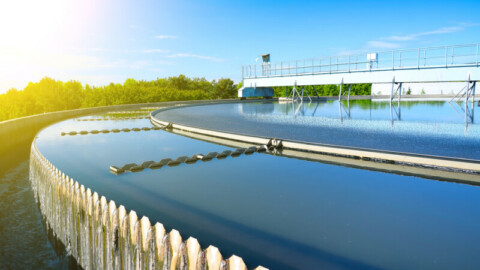For over 14 years the Moe Wastewater Treatment Plant has been effectively and successfully processing sewage. Located in Gippsland, Victoria, the medium-sized plant serves an equivalent persons population of 22,000. Its average daily flow is five mega litres per day.
Starting in February 2010, the plant’s wastewater treatment engineers noticed that its two submersible pumps (one duty pump and a standby pump) at the inlet station were blocking up with increasing regularity, making them virtually ineffectual and impacting on the efficiency of the plant.
‘Between February and the start of December 2010 our submersible pumps were choking about once a fortnight. The pumps were no longer capable of effectively handling the rags and other solid material in the inflow,’ explained Adrian Harper, Senior Engineer Wastewater Treatment Group, Moe Wastewater Treatment Plant.
To deal with the problem, the plant operator would call in their maintenance contractors to isolate the obstructed submersible pump, lift it using a crane and then clean it before lowering the pump back into the wet well.
According to Adrian the entire exercise was time consuming, inconvenient, expensive and negatively impacted on the plant’s performance.
“Between February and December 2010 we spent some $27,000 just on getting the contractors in to clean the pumps,’ said Adrian.
The problem also created OH&S headaches as it required the continual lifting by crane and cleaning of a 700kg submersible pump. The whole process increased the risk of accident when the plant was committed to improving its safety profile.
By about May the situation had become untenable and Adrian and his colleagues were keen to find a permanent and effective answer to the choking pump problem.
Impressed with the solutions that Hydro Innovations had exhibited at a tradeshow, Gippsland Water invited the company to assess their dilemma and provide a workable option. After exploring the site and the needs of the plant, Hydro Innovations suggested that it consider installing an above ground Gormann-Rupp self-priming pump.
To evaluate Hydro Innovation’s solution as well as to explore the pros and cons of a self-priming pump versus a submersible pump with a cutter impeller, Gippsland Water initiated an option study. The study confirmed that a self-priming pump would be a workable solution.
‘We had never used an above ground, self-priming pump at the plant before, and although we were happy to think outside the box, and the study had confirmed that such a solution was viable we weren’t entirely convinced. So we asked Hydro Innovations if we could trial the pump for three months which they readily agreed to because they were certain the pump would meet our needs,’ explained Adrian.
Hydro Innovations provided the plant with a Gorman-Rupp T8A3S-B above-ground self-priming centrifugal pump in December 2010. By mid-December the pump was installed and in use.
According to Garry Grant, General Manager of Hydro Innovations, the Gorman-Rupp T8A3S-B self-priming centrifugal pump is a purpose-built sewage pump that is fitted with an aggressive self-cleaning wear plate. The wear plate has been specifically designed to change the shape of solid waste and stringy material so that the pump does not clog. In addition, if any choking does occur, the pump can be easily and quickly unclogged via the removable cover plate and without the need to disconnect piping. Better still, it can be done with only one operator and without the need for a lifting device.
The design of the pump allows users to adjust the clearance between the impeller and wear plate without having to pull it apart. This eliminates the need to realign belts, couplings or other drive components. The machine’s unique collar and adjusting screw allow for incremental adjustments of the wear plate clearance. Once made, the collar locks in place maintaining the clearance setting. These features help double the life of the impeller and the wear plate while maintaining peak operating efficiency.
After the three-month trial period, Gippsland Water was impressed with the Gorman-Rupp pump’s performance and purchased the machine.
‘Its now May 2011 and our Gorman Rupp self-priming pump has been in operation for about five months. It did slightly block a couple of times but it still kept pumping and overall it has made a huge, positive impact on the processing efficiency of our plant. It performs very well and delivers 110 litres per second at 8.9 metres of total head.
‘Also, we are no longer wasting money on cleaning the pumps fortnightly. Plus, the down time associated with this as well as the inconvenience have been eliminated. If the pump does need cleaning the design of the pump lets you do it quickly and of course, its done above ground so we don’t have to worry about OH&S issues arising.
‘Another big plus with the Gorman-Rupp pump is that if you do get a malfunction occurring in the motor you can just replace the motor. This isn’t possible with submersible pumps. If there is a motor problem you have to change the entire pump,’ said Adrian.
With no regrets about having purchased a Gormann-Rupp self-priming pump, Gippsland Water is now planning to replace its other submersible pump at the Moe WWTP with a self-priming pump.
‘As an engineer I grew up on submersible pumps but having now been exposed to an above ground centrifugal pump I’d say they have a lot to offer and should be seriously considered as a pump option in a wastewater treatment plant,’ concluded Adrian.















